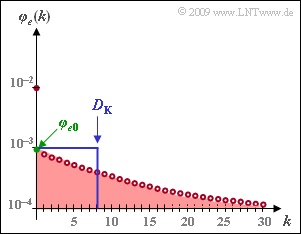Difference between revisions of "Aufgaben:Exercise 5.6: Error Correlation Duration"
From LNTwww
| Line 2: | Line 2: | ||
{{quiz-Header|Buchseite=Digitalsignalübertragung/Bündelfehlerkanäle}} | {{quiz-Header|Buchseite=Digitalsignalübertragung/Bündelfehlerkanäle}} | ||
| − | [[File:|right|]] | + | [[File:P_ID1842__Dig_A_5_6.png|right|frame|Fehlerkorrelationsfunktion beim GE–Modell]] |
| + | Die Grafik zeigt die Fehlerkorrelationsfunktion (FKF) des Gilbert–Elliott–Modells mit den Parametern | ||
| + | :$$p_{\rm G} \hspace{-0.1cm} \ = \ \hspace{-0.1cm} 0.001, | ||
| + | \hspace{0.2cm}p_{\rm B} = 0.1,$$ | ||
| + | :$$ {\rm Pr}(\rm | ||
| + | G\hspace{0.05cm}|\hspace{0.05cm} B)\hspace{-0.1cm} \ = \ | ||
| + | \hspace{-0.1cm} 0.1, \hspace{0.2cm} {\rm Pr}(\rm | ||
| + | B\hspace{0.05cm}|\hspace{0.05cm} G) = 0.01\hspace{0.05cm}$$ | ||
| + | |||
| + | in logarithmierter Darstellung. | ||
| + | |||
| + | Dieses Modell wird in der Aufgabe [[ Aufgabe Z5.6]] ausführlich behandelt. Insbesondere wird in dieser Aufgabe auch die Fehlerkorrelationsfunktion (FKF) berechnet. Mit den Hilfsgrößen | ||
| + | :$$A \hspace{-0.1cm} \ = \ \hspace{-0.1cm} (p_{\rm B}- p_{\rm M}) | ||
| + | \cdot (p_{\rm M}- p_{\rm | ||
| + | G})\hspace{0.05cm},$$ | ||
| + | :$$B\hspace{-0.1cm} \ = \ \hspace{-0.1cm} {\rm Pr}(\rm | ||
| + | B\hspace{0.05cm}|\hspace{0.05cm} G) + {\rm Pr}(\rm | ||
| + | G\hspace{0.05cm}|\hspace{0.05cm} B)$$ | ||
| + | |||
===Fragebogen=== | ===Fragebogen=== | ||
| − | |||
<quiz display=simple> | <quiz display=simple> | ||
| − | {Multiple-Choice | + | {Multiple-Choice |
|type="[]"} | |type="[]"} | ||
| − | + | + correct | |
| − | + | + | - false |
| − | |||
{Input-Box Frage | {Input-Box Frage | ||
|type="{}"} | |type="{}"} | ||
| − | $\ | + | $xyz \ = \ ${ 5.4 3% } $ab$ |
| − | |||
| − | |||
| − | |||
</quiz> | </quiz> | ||
===Musterlösung=== | ===Musterlösung=== | ||
{{ML-Kopf}} | {{ML-Kopf}} | ||
| − | '''(1)''' | + | '''(1)''' |
| − | '''(2)''' | + | '''(2)''' |
| − | '''(3)''' | + | '''(3)''' |
| − | '''(4)''' | + | '''(4)''' |
| − | '''(5)''' | + | '''(5)''' |
| − | |||
| − | |||
{{ML-Fuß}} | {{ML-Fuß}} | ||
| − | |||
[[Category:Aufgaben zu Digitalsignalübertragung|^5.3 Bündelfehlerkanäle^]] | [[Category:Aufgaben zu Digitalsignalübertragung|^5.3 Bündelfehlerkanäle^]] | ||
Revision as of 11:28, 14 November 2017
Die Grafik zeigt die Fehlerkorrelationsfunktion (FKF) des Gilbert–Elliott–Modells mit den Parametern
- $$p_{\rm G} \hspace{-0.1cm} \ = \ \hspace{-0.1cm} 0.001, \hspace{0.2cm}p_{\rm B} = 0.1,$$
- $$ {\rm Pr}(\rm G\hspace{0.05cm}|\hspace{0.05cm} B)\hspace{-0.1cm} \ = \ \hspace{-0.1cm} 0.1, \hspace{0.2cm} {\rm Pr}(\rm B\hspace{0.05cm}|\hspace{0.05cm} G) = 0.01\hspace{0.05cm}$$
in logarithmierter Darstellung.
Dieses Modell wird in der Aufgabe Aufgabe Z5.6 ausführlich behandelt. Insbesondere wird in dieser Aufgabe auch die Fehlerkorrelationsfunktion (FKF) berechnet. Mit den Hilfsgrößen
- $$A \hspace{-0.1cm} \ = \ \hspace{-0.1cm} (p_{\rm B}- p_{\rm M}) \cdot (p_{\rm M}- p_{\rm G})\hspace{0.05cm},$$
- $$B\hspace{-0.1cm} \ = \ \hspace{-0.1cm} {\rm Pr}(\rm B\hspace{0.05cm}|\hspace{0.05cm} G) + {\rm Pr}(\rm G\hspace{0.05cm}|\hspace{0.05cm} B)$$
Fragebogen
Musterlösung
(1)
(2)
(3)
(4)
(5)
